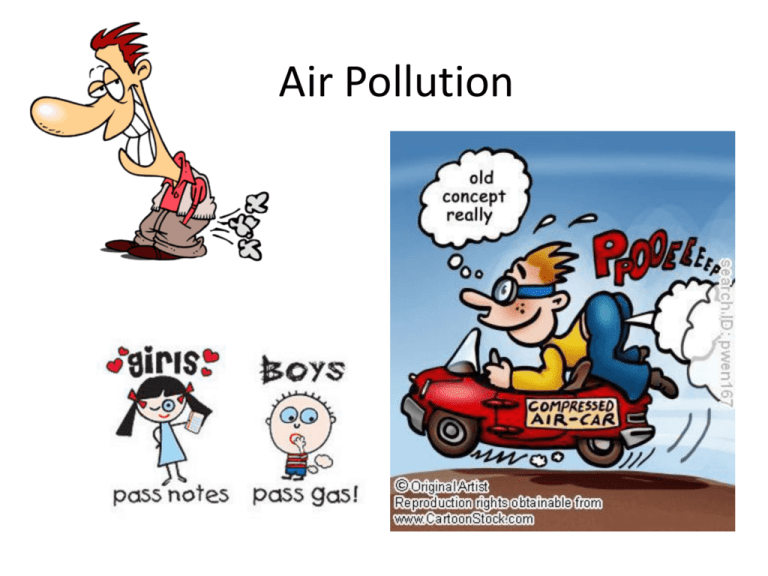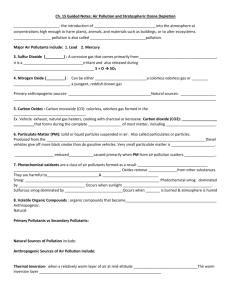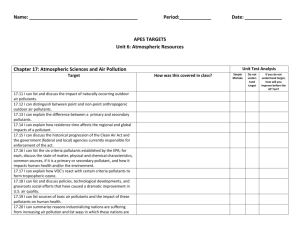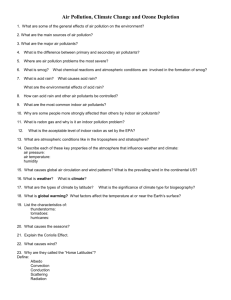Air Pollution - NAAE Communities of Practice
advertisement

Air Pollution WHAT IS AIR? • Air is the ocean we breathe • Supplies us with oxygen which is essential for our bodies to live • Air is 99.9%: – – – – Nitrogen Oxygen Water vapor Inert gases • Human activities can release substances into the air, some of which can cause problems for humans, plants, and animals. WHAT IS AIR POLLUTION • Air pollution comes from many different sources: – – – – – Factories Power Plants Cars Windblown Dust Wildfires • Air pollution threatens the health of: – – – – – – Humans Trees Lakes Crops Animals Ozone Layer • Air pollution also causes: – Haze, reducing visibility How Pollution Is Formed Primary vs. Secondary • Primary Pollutants: emitted directly from a source • Secondary Pollutants: formed in the atmosphere as a result of interactions between 2 or more chemicals in the air Sources of Pollutants #1- Stationary Sources • Larger sources of pollution that are always in the same place – Oil/Chemical Refineries – Power Plants – Factories Sources of Pollutants #2- Area Sources • Smaller sources of pollution that are always in the same place – Dry Cleaners – Auto Body Shops – Volcanoes – Forest Fires Sources of Pollutants #3- Mobile Sources • Travel from one place to another – Cars – Buses – Trucks Physical Phases of Pollutants • Gaseous- chemicals in their low-density, elastic, aeriform state • Particulate: small solid fragments light enough to be suspended in the air Regulatory Categories Criteria Air Pollutants vs. Hazardous Air Pollutants • Criteria: US Government Top 6 Common Pollutants: – – – – – – Carbon Monoxide Lead Nitrogen Ozone Particulate Matter Sulfur Dioxide Causes: - Premature Mortality - Asthma Attacks - Acid Rain Regulatory Categories Criteria Air Pollutants vs. Hazardous Air Pollutants • Hazardous: chemical which can cause adverse effects to human health or the environment, almost 200 of these chemicals have been identified Causes: - Cancer - Birth Defects Risk and Health Effects of Air Pollutants • 130 million people live in countries with unhealthily air Possible Health Effects • Carcinogenic- can cause cancer, these compounds are found in indoor and polluted outdoor urban air • Respiratory- impacts lungs and breathing • Neurological- impacts the nerve and brain development • Immunological- affects the body's immune system • Reproductive: affects ability to have babies • Developmental: affects the proper physical/mental development • Circulatory: affects the circulation of blood/heart function Ecological Effects • Acid Rain- caused when fossil fuel emissions of sulfur and nitrogen oxides combines with water in the atmosphere • Precipitation with a pH less than 5.6 • Acid Rain Causes: – – – – – – Decay of building materials Paints Statues Sculptures Death to plants Death to aquatic life Ecological Effects • Global Warming- the increase in the average temperature of the earth’s atmosphere • Ozone Depletion: the ozone layer in the stratosphere protects the earth from harmful ultraviolet radiation from the sun, air pollution causes the layers of the ozone to deplete • Smog- smoke, fog, mixture of air pollutants which form a haze in the air Ways To Detect Air Pollution • Smell: some chemicals can be identified by their smell – Chlorine – Hydrogen Sulfide (smells like rotten eggs) • Sight: smog, haze, smoke • Taste: pollutants like sulfur can actually be detected with the tongue (tastes metallic)






